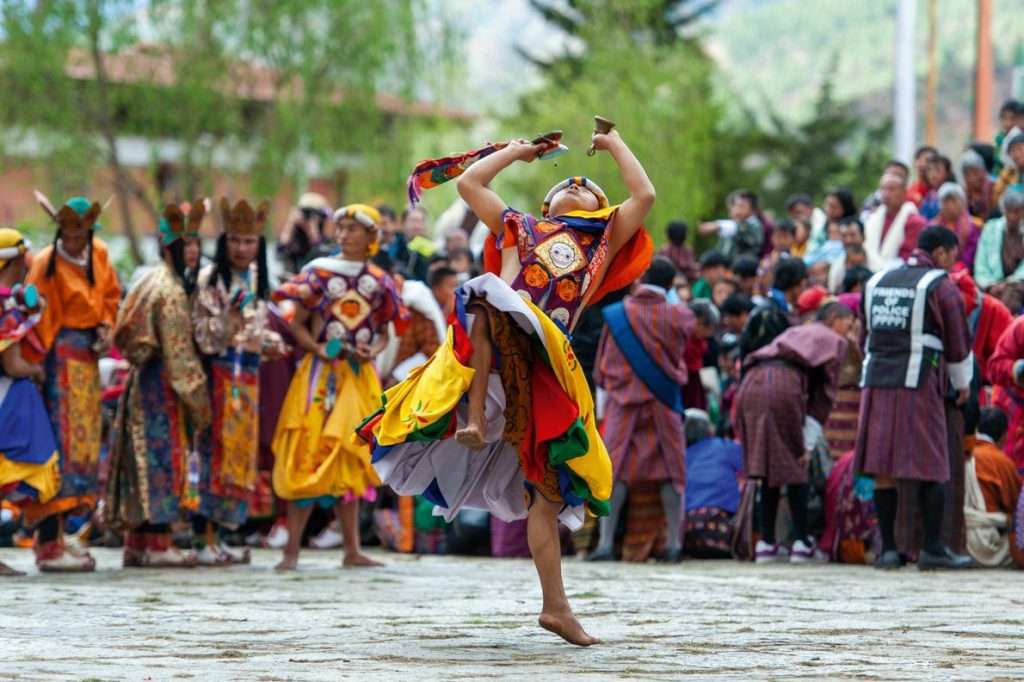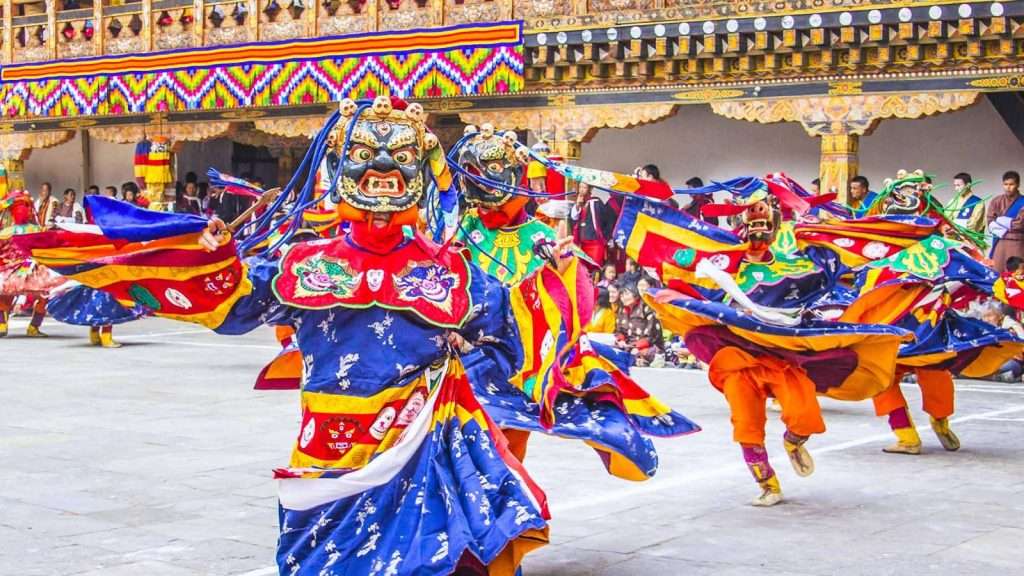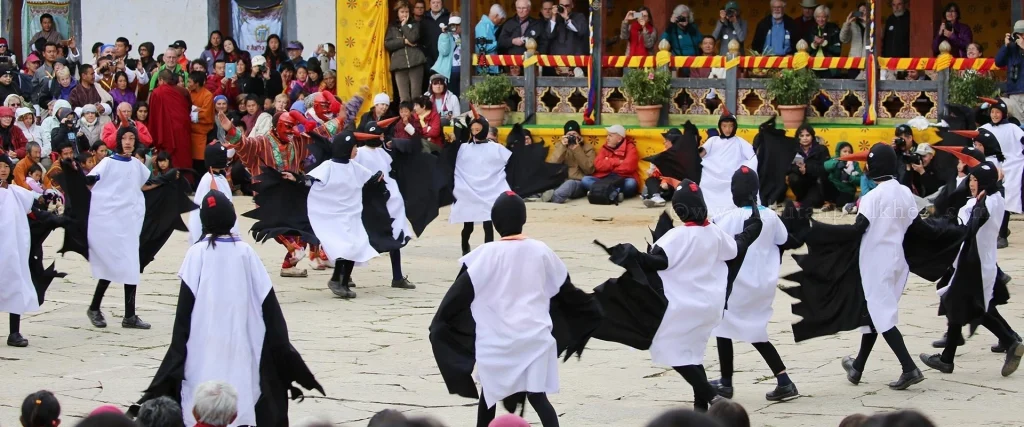Bhutan, the hidden gem ensconced within the majestic Eastern Himalayas, is a land of contrasts, renowned not merely for its awe-inspiring natural beauty but equally for its deep and rich cultural tapestry. This kingdom, shrouded in mystique, opens its doors to a world where tradition and modernity coalesce, revealing a tapestry woven with vibrant threads of history, spirituality, and natural splendor.
We hold a steadfast belief that to truly understand and appreciate the essence of this mysterious land, one must experience its Tsechus, the traditional festivals. These festivals are the heartbeat of Bhutanese culture, serving as living, breathing manifestations of the nation’s spirit and its centuries-old traditions. They are the windows to the soul of Bhutan, allowing those who seek to understand this kingdom to immerse themselves in its rich culture, harmonious music, and expressive dance forms.
These festivals are not mere celebrations; they are a spiritual journey, a dance of colors and emotions, a symphony of sounds that resonate with the echoes of the past, and a visual feast that reflects the vibrant tapestry of Bhutanese life. They are a time when the air is imbued with the melody of traditional music, the ground vibrates with the rhythmic steps of dancers, and the atmosphere is saturated with the fragrance of incense and the warmth of shared joy and spirituality.
Paro Tshechu Festival

Situated in the Eastern Himalayas, the Paro Tshechu Festival is a vibrant embodiment of Bhutan’s unique philosophy of Gross National Happiness, reflecting the country’s commitment to the well-being of its people over material pursuits. Initiated by the 4th king, Jigme Singye Wangchuck, in the 1970s, it draws numerous visitors annually.
Celebrated every March, it signifies the blooming of trees and magnolias. It began as a consecration ceremony for Dzong Paro Rinpung in the 17th century and has transformed into an annual event honoring Guru Rinpoche, the “Lotus-Born Teacher” who brought Tantric Buddhism to the Himalayas in the 8th century. The festival, spanning five days, re-enacts the sacred activities of the Guru through dance, folksongs, and music, fostering a deep spiritual connection for both locals and tourists.
A major attraction is the Thongdrol, a colossal embroidered thangka depicting Guru Rinpoche and his various manifestations. It is unveiled once a year during the festival, drawing devotees from across Bhutan to receive blessings believed to liberate them from sin and evil.
Thimphu Tshechu Festival

Thimphu Tshechu, held in Bhutan’s capital, Thimphu, is a grand annual religious festival showcasing Bhutan’s rich culture and spiritual traditions. It is celebrated for three days, starting from the 10th day of the 8th month of the lunar calendar, and is one of the most magnificent festivals in Bhutan, attracting a vast audience.
Initiated by the 4th Desi, Gyalse Tenzin Rabgay in 1867, and later expanded by the third King of Bhutan, Jigme Dorji Wangchuck, in 1950, the festival is a religious event celebrated on the tenth day of a month of the lunar calendar, corresponding to the birthday of Guru Rimpoche (Guru Padmasambhava). The exact month of the Tshechu varies from one district to another.
The festival is a convergence of traditional dances, including the Zhana chham and the Zhana Nga chham (Dances of the 21 Black Hats), Durdag (Dance of the Lords of Cremation Ground), and Drametse Nga chham (Dance of the Drums from Drametse). The unfurling of the thongdrel (a giant religious banner) is a major highlight, displayed for the public to receive blessings.
Punakha Drubchen Festival

Punakha Drubchen is a distinctive festival in the Punakha district of Bhutan, commemorating Bhutan’s victory over Tibetan invaders in the 17th century. It is a blend of history and spirituality, held in the magnificent Punakha Dzong, also known as “The Palace of Great Happiness,” located at the confluence of the Pho Chhu and Mo Chhu rivers.
The festival pays homage to Zhabdrung Ngawang Namgyal, the Bhutanese leader who introduced the dual system of governance and played a crucial role in defending Bhutan against Tibetan forces. It serves as a prelude to the Punakha Tshechu, a more religious festival with mask dances and traditional performances, following immediately after the Drubchen.
Black Necked Crane Festival

The Black Necked Crane Festival is a harmonious amalgamation of Bhutanese culture and nature, held in the scenic Phobjikha Valley. It aims to raise awareness about conserving the endangered Black Necked Cranes, which migrate to the valley during winter from the Tibetan plateau.
Held at the Gangtey Monastery, the festival features cultural programs, folk songs, dances themed around the cranes, and mask dances performed by locals. Initiated in 1998, it has become a vital part of local culture in Phobjikha Valley, attracting numerous tourists and offering them a chance to immerse in Bhutan’s rich cultural heritage.
Jambay Lhakhang Drup Festival

The Jambay Lhakhang Drup is a significant festival in Bhutan, celebrated with vibrant festivities and deep reverence. It commemorates the establishment of the Jambay Lhakhang temple in the 7th century and serves as a tribute to Guru Rimpoche, who introduced the Tantric form of Buddhism to Bhutan.
The festival is a visual and holistic experience, offering insights into the rich cultural tapestry and spiritual ethos of Bhutan. It features a variety of activities including a famous drum beat dance, a clown dance called Dola Pangtoy Shazam, and Raksha Mangcham, symbolizing life after death. The festival serves as a medium to impart moral instructions, drive away evil spirits, and celebrate the Buddhist faith in its diverse forms.

